Check out my custom vibration dampener
How Often to Restring Your Tennis Racquet
Guide + Video
We hope you love this article. Just so you know, TennisCompanion may collect a small share of sales from the links on this page to help keep this site running. Learn more.
One of the most common questions I get about tennis strings is, “How often should they be replaced?” It’s a great question and one that many players don’t give a whole lot of consideration.
As you may be aware, strings wear down from play and subsequently lose their tension and resilience. If left too long, it can negatively affect your performance, comfort, and feel. However, knowing why it’s essential to restring is only half the battle.
In this guide, I’m exploring the topic thoroughly and sharing the information necessary to come up with an ideal stringing frequency. I’ll also cover what to look for, so you know when it’s time to take your racquet in for service to prevent any adverse side effects.
Article Contents
Click below to jump to a section
Tap below to jump to a section
When to Restring Video
Why Change Your Strings
Replacement & String Types
Outdated Rule of Thumb
Restringing Factors
When It’s Time to Restring
Tools for Restringing
Cost of Restringing
Where to Restring
New to TennisCompanion?
Create a free account and explore my latest videos below
When to Restring Video
There are rough guidelines you can use as a starting point to determine how often to replace your tennis strings.
However, as covered in this video, it’s best to understand the benefits of restringing while considering a handful of additional factors to come up with an ideal stringing frequency that makes sense for you.
Here are timestamps you can reference for different sections of the video.
0:00 – Start
0:25 – Intro
0:40 – Why Restring?
1:53 – Factors to Consider
2:07 – Rough Restringing Guidelines
3:28 – Types of String
4:47 – When to Restring
6:12 – Tension Tester Tools
6:46 – Closing Thoughts
7:09 – Wrapping Up
Here’s a link to my resource about the different types of tennis strings that I reference in the video. This guide serves as a helpful companion while also covering a few additional topics not discussed in the video.
Why Change Your Tennis Strings?
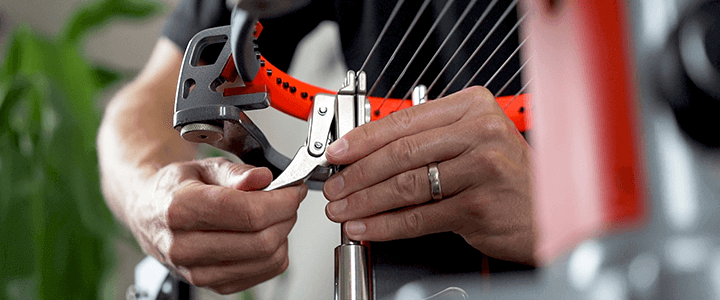
Many players won’t restring their racquet until the strings break.
For some casual players who hit a few times per year, that’s perfectly fine. However, more often than not, you’ll benefit from stringing sooner.
Here are a few of the top reasons players should restring their tennis racquet periodically.
Tension Loss
The first, and most apparent reason, to replace your tennis strings is that they will lose tension over time.
When you install a new set of strings, it’s kind of like purchasing a car. The moment you drive a new car off the lot, it automatically loses value.
Similarly, your tennis strings begin to lose their tension immediately after you string. In the first 24 hours after stringing, strings can lose roughly 10 percent of their tension. This reduction in tension continues as time goes by, and you get out on the court and start hitting.
Although tension loss is a natural part of stringing, it can reduce a player’s ability to control the ball effectively if left too long.
String Performance
As your strings go dead, they begin to lose their performance characteristics, which you may have bought them for in the first place.
For example, polyester strings can help a player maximize their potential for topspin. However, as they lose their tension, they also lose their resilience and snapback effect, which is part of how they help players generate topspin.
Similarly, if you play with a multifilament tennis string because they provide you with power, then your pace and depth of shot will decline.
As a result, if you want to maintain the best performance form your strings, it pays to restring regularly.
Reduce Shock
Maintaining a freshly strung racquet can help cut down on shock and increase comfort because strings lose their resilience, which aids in providing players with a softer response.
Any players suffering from tennis elbow or general arm discomfort should keep a close eye on their strings and, within reason, restring more frequently to ensure optimal health.
Of course, if comfort is a top priority, you’ll want to be using an arm-friendly string. However, even the best strings for tennis elbow will lose their comfort factor over time.
Prevent Overcompensation
One of the worst things that can happen to a player is they begin to adjust their technique, or an instructor or coach tells them to adapt their technique to compensate for a loss in tension with their strings.
Since your strings’ tension can have a significant impact on the power and control you generate when hitting, it’s worth replacing your tennis strings consistently to make sure you can perform your best.
Avoid Frustration
Most recreational players only have one tennis racquet. As a result, if you break a string, it’s likely to prevent you from playing altogether or cutting your playing time short.
There’s nothing more frustrating than showing up excited to play only to break your strings after your first few hits. Regularly restringing can help ensure you get to take advantage of every minute you set aside to play.
String Replacement and the Different Types of Strings

When it comes to replacing your tennis strings, it’s important to note that different strings will do a better job maintaining their tension and resilience over time. In some cases, you may hear this referred to as tension maintenance or playability duration.
Let’s take a quick look at the different types of tennis strings and how well they keep their tension. For reference, we’ve included examples of each string that are well-known for maintaining their tension.
Natural Gut
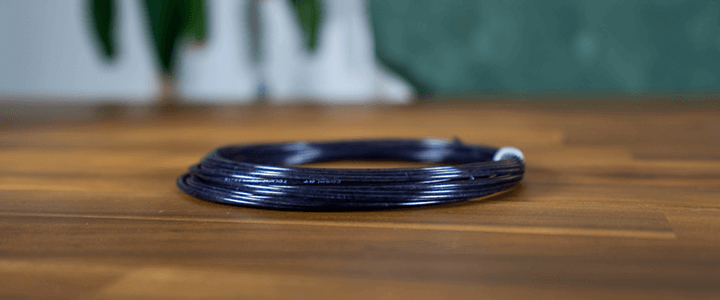
Natural gut strings are made from cow intestine and are well known for offering best in class tension maintenance and resilience.
Assuming they don’t break, they’ll last longer than other strings, but they’re also expensive, so it’s a bit of a tradeoff. One way to help cut down on the cost of using natural gut is to string them as part of a hybrid setup where you combine two different types or gauge of string.
| Natural Gut Examples |
| Babolat VS Touch |
| WilsonNatural Gut |
Synthetic Gut

Most commonly made from nylon, synthetic gut strings are the most affordable group of strings with a wide selection that offers moderate tension maintenance, requiring more regular restringing.
| Synthetic Gut Examples |
| Prince Synthetic Gut |
| Gosen OG Sheep |
Multifilament

Also typically made from nylon, multifilament strings seek to replicate natural gut in their construction using synthetic materials.
Typically, they do a great job maintaining their tension with great comfort and feel at a reasonable price relative to natural gut.
| Multifilament Examples |
| Tecnifibre Multifeel |
| Babolat Xcel |
Polyester
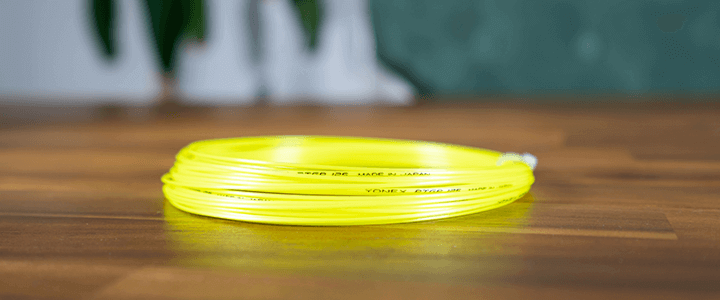
Polyester tennis strings are some of the most popular due to their low power and high spin potential. Although durable, they are notorious for losing tension fast, so while they’re less likely to break, players need to replace them more frequently, which can get expensive.
| Polyester Examples |
| Yonex Poly Tour Spin G |
| Luxilon ALU Power Soft |
Kevlar
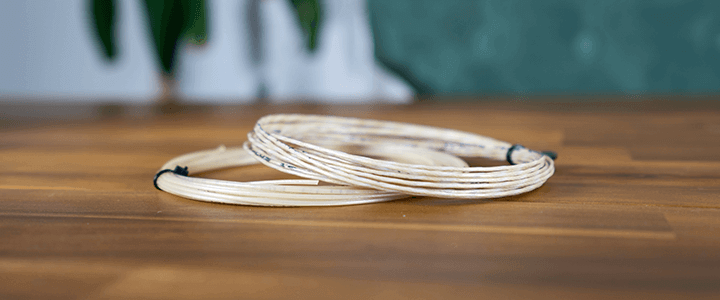
Kevlar strings are made from highly durable aramid fibers and do an excellent job maintaining tension, but due to their harsh feel and low comfort, they are less popular.
As a chronic string breaker myself, I grew up playing with kevlar as part of a hybrid setup, which meant I could get away with restringing less frequently and, despite the lower performance, helped us save money.
| Kevlar Examples |
| Prince Pro Blend |
| Crossfire Plus |
Here’s a chart to recap the differences.
| String Type | Tension Maintenence |
| Natural Gut | High |
| Synthetic Gut | Medium |
| Multifilament | Medium-High |
| Polyester | Low |
| Kevlar | High |
All in all, the type of strings you choose will influence how frequently you need to string. If you’d like more options of strings to consider, check out my list of the best strings for 2020.
Outdated Rule of Thumb

Somewhere along the way, there was a general rule of thumb established that said you should replace your strings as many times per year as you play per week. Under this outdated rule, if you played three times per week, you’d restring your racquet three times per year.
For some players, such as casual recreational players who aren’t competing, this may be a decent rule. However, it can be misleading for those who hit the court regularly and take their performance seriously.
For many players, the general rule of thumb also breaks down in practicality, since most players don’t play the same amount of times every week. You might play twice one week, five times the next and not at all the following week.
As such, I’d recommend against using this method for determining when to restring your tennis racquet.
Restringing Factors to Consider

The frequency at which any given player strings their racquet is going to be different for everyone. However, there are a few factors you can keep in mind to help determine when it’s time to replace your strings:
- Frequency and duration of play
- Style of play
- Level of competition
- Budget
- Comfort
- Environment
- Personal preference
Let’s dive into each separately.
Frequency & Duration of Play
While stringing your racquet as many times per year as you play per week rule can be misleading for many players, the concept of restringing based on your frequency is perfectly reasonable, i.e., the more frequently you play, the more you should restring.
If you’re looking for a general rule purely based on frequency, and you tend to play roughly the same amount each week, we’d recommend you take the number of times you play per week and double that number to find out approximately how many times per year you should string.
That means if you’re playing seven days a week, you should restring about once a month. Here’s a look at how that breaks down depending on how many days per week you play.
| Play/Week | Restring/Year | Days | Months |
| 1 | 2 | 183 | 6.0 |
| 2 | 4 | 91 | 3.0 |
| 3 | 6 | 60 | 2.0 |
| 4 | 8 | 45 | 1.5 |
| 5 | 10 | 37 | 1.2 |
| 6 | 12 | 30 | 1.0 |
| 7 | 14 | 26 | 0.9 |
Based on my experience, that’s a more logical approach, but it’s still not perfect, and you end up with roughly the same recommendation if you’re playing five to seven days a week.
Moreover, if you’re playing seven days a week for 30 minutes vs. seven days a week for three hours, you’ll still have to make a judgment call on how fresh, and consistent you want the tension of your strings.
With that in mind, let’s dive into some other factors to consider.
Style of Play
Another factor to consider is your style of play. If you hit soft with an eastern grip and you come to the net a lot, then you might not have to string your racquet as often because your strings won’t take as much of a beating.
On the other hand, if you’re a hard-hitting baseliner with a semi-western or western grip, then you might need to string your racquet more frequently since the friction and therefore wear of your strings will be significantly greater.
Level of Competition
As the stakes increase and you compete at a higher level, it becomes more critical to control the elements of your game that you can. Stringing is one of those elements, and it’s all about consistency.
When you practice and play matches, you’re going to want the tension of your racquet to be virtually the same every time, so you’re not compensating for the loss in tension.
You may want to vary the tension of your racquet depending on conditions or how you’re playing on a given day, but it becomes more critical that you know what to expect from the tension change.
As such, restringing frequently tends to become more crucial at higher levels of competition, such as in professional tennis, where players often have their racquets strung fresh every time they hit the court.
Budget
For most players, their budget is simply a fact of life. You may be hitting the court seven days a week for three hours a day, but if you can’t afford to restring your racquet frequently, then you’re not going to, and that’s perfectly fine. Of course, budgets will vary for every player, but it’s worth considering.
If budget is a concern, you may also want to consider the type of tennis strings that you’re using. Depending on the material, construction, and gauge of your strings, you can begin to reduce the frequency at which you’ll need to restring.
Comfort
If comfort is a concern for you, then you should restring your racquet more frequently because dead strings result in more shock to your arm and may lead to injuries like tennis elbow or aggravate an existing injury.
Environment
The environment can have a substantial impact on the performance and longevity of strings, and various strings respond differently.
Excessive heat, cold, and humidity can cause strings to age prematurely and require faster or more frequent replacement.
For example, natural gut strings like to absorb moisture, so humid conditions in Florida can make it more challenging to maintain them. Polyester strings, on the other hand, can lose their elasticity in the excessive heat and sun.
As a result, where you live can influence restringing, and regardless of where you live, it can help keep your racquets protected from the elements. Many of the best tennis bags offer pockets or sections with a thermal lining to help extend your strings’ lives.
Personal Preference
If you’re playing tennis and learning for fun and your coach or instructor tells you that you should restring your racquet every other week, but you’re really not all concerned with the variation in tension, then wait until you’re ready to restring.
At the end of the day, it’s up to you, and knowing why you should restring and what happens if you don’t is helpful, but there’s no right or wrong answer.
These factors, combined with the chart I shared earlier, can help you come up with a frequency that makes sense for you.
How to Know When It’s Time to Change Strings
There are a few different things you can keep in mind to help you determine when it’s time to change your strings.
Visual Indicators
In some cases, it’s relatively easy to spot when it’s time to replace your strings by giving them a close look.
Aside from a broken string that requires replacement, here are some visual indicators to monitor.
Notching
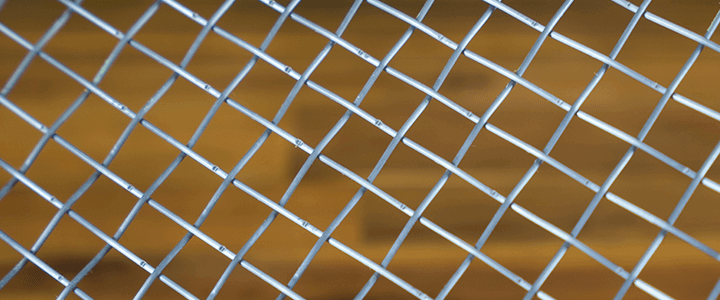
As you play tennis, your strings will rub together and produce friction, which causes the strings to notch. If you look closely, you’ll notice that notches form at the intersection of strings toward the middle of your racquet.
If you see that these notches are getting deep and cutting roughly half to three-quarters of the way through, then it’s likely a good time to restring.
Fraying
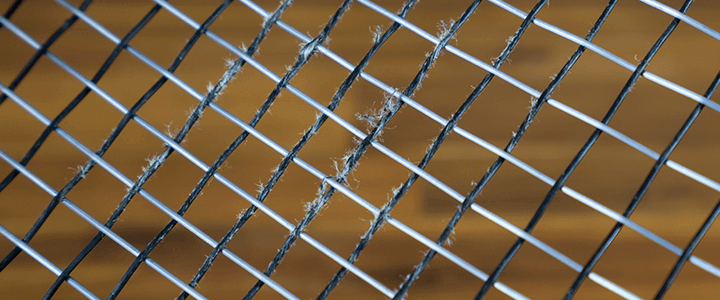
Natural gut, multifilament, and kevlar strings are composed of tiny fibers that will fray over time. It’s a natural part of the wear for these strings, but it can be a great indicator of when you might want to consider restringing as it intensifies.
Keep in mind that polyester strings won’t fray because they feature a single solid filament construction. Although synthetic gut strings are often composed of multiple filaments, they usually don’t show signs of fraying.
Feel Indicators
As a beginner, some of these sensations will be difficult to detect. However, as you play more and your feel improves, you’ll get better at sensing these changes.
- A Loss in Control: As your strings wear and lose tension, it can become more challenging to control the ball. It usually won’t be drastic, but if you’re finding yourself hitting just long, hitting more unforced errors, or having difficulty placing the ball, then it might be time for you to restring.
- Difficulty Generating Spin: As certain strings like polyester lose tension, there will be a reduction in the snapback of the main strings, which leads to the feeling that it’s harder to generate topspin. If you sense this feeling, and it’s been a while since your last string job, you might be time for a new set.
- Lack of Pop: When your strings are fresh, they’re also resilient, which means they can effectively return energy to the ball. As time goes on, your strings will lose their resilience, making it challenging to hit with as much power.
- Lower Comfort: Fresh strings do a better job of absorbing shock. However, over time, they’ll stretch and lose their resilience and, in turn, provide a stiff or dead feel that can translate to an uncomfortable hitting experience. If you begin to experience discomfort, then it might be time to restring.
All in all, the feel and response of your strings will change over time. Each player might describe the change in their strings differently, but as you begin to detect these changes, you’ll become more confident in knowing when to restring.
Although it’s all too easy to blame strings for poor performance, if you have a few rough hits at the court, and a few weeks have passed since your last string job, then there’s a good chance your strings aren’t helping the cause.
When in doubt, I’d encourage you to err on the side of restringing more frequently for optimal performance.
Tools for Measuring Tension Loss & Restringing

If you’re looking to get a bit more scientific, then there are tools you can use to help measure when it’s time to change your strings. More specifically, you can use a relatively inexpensive string tension gauge.
Each gauge works by measuring the tension of your strings after your racquet is restrung to get a baseline. Keep in mind that these tools won’t report the same tension set by your stringer during installation, and that’s okay. You’re only looking for a point of reference.

Then, you periodically take measurements, and when there has been roughly a 10 to 15 lb (4.54 – 6.80 kg) or 30% drop in tension, you’ll know it’s time to restring.
Of course, you can choose your threshold for when it’s time to restring based on your preference that you determine after using the tool.

Here are a few popular models:
| Restringing Tools |
| Pro’s Pro tension calibrator |
| Tourna string tension tester |
| Gamma string tension tester |
It’s worth noting that you don’t measure the drop in tension based on the reference tension, i.e., the tension that you requested your stringer to use, as this will be higher from what a gauge measures after the stringing job is complete.
Another route you can take is to ask your local pro shop or look for one that can measure stringbed deflection with a machine like the Babolat racquet diagnostic center.
Similar to a using a gauge, by measuring stringbed deflection immediately after stringing, you can get a baseline for use in comparing your strings at a later date.
Cost of Restringing a Tennis Racquet

The cost of restringing a tennis racquet varies based on the type of string you choose, and the labor charged. With this in mind, players can expect to spend between $15 to $65 to have their racquet restrung.
Price of Tennis strings
The price for a set of tennis strings ranges from just under $5 for an inexpensive synthetic gut, all the way up to nearly $45 for a high-end natural gut.
Some professional stringers will purchase a selection of tennis strings by the reel, i.e., in bulk, and will be able to offer more competitive prices.
However, all stringers will happily string your racquet with a set of strings you provide, if they don’t carry one that you’d prefer.
Price for Labor
In most cases, the labor for restringing a tennis racquet will cost you between $10 and $20. However, some individuals who specialize in racquet stringing and care may command higher prices.
Where to Restring a Tennis Racquet

Most of the time, your local tennis club or store will offer restringing services, and that’s where we’d recommend you start your search.
If not, you may find that coaches and instructors have machines and offer stringing services for their students, which is another excellent option.
Keep in mind that not all stringers area created equal. Some individuals will have specialized certifications like RacquetTech’s Master Racquet Technician designation, while others will string casually.
For the best result, find a stringer you can trust from a referral and stick with them to ensure you get a consistent string job each time. The person stringing and how well their stringing machine is maintained, will impact the final result.
Wrapping Up
If you decide to take up tennis as a sport, it’s helpful to be aware that regularly restringing your racquet is a normal part of maintenance.
Early on, as you’re learning how to play, the frequency at which you restring will be less relevant as you develop proper skill and technique. However, as you improve and become more competitive, you’ll likely want to increase how often you string your racquet to maintain the highest level of performance.
How often do you restring your racquet? I’d love to hear from you in the comments below. Of course, if you have any questions, drop us a note – we’d be happy to help out.
Play Better Tennis
Improve your game alongside our community of tennis players
Why join?
Discussion Boards
Join the conversation with other members of the community.
5 Point Friday
Read our weekly recap of the 5 most interesting things we dig up in tennis.
Trackbacks & Pingbacks
Leave a Reply
Want to join the discussion?Feel free to contribute!



Another great way to determine if a string change is needed is to pull a few of crosses out of place. If the strings were “sticking” and there are gouges in the mains where the crosses were sitting, you may need to replace strings. This doesn’t work as well with poly’s as they don’t gouge as easy.
Hi Michael,
You’re absolutely right – that’s a great test to check for signs of wear and tear. To your point, notches form pretty regularly with synthetic gut and multifilament strings, so it’s worth keeping an eye on the physical appearance of the strings along with how they feel.
I appreciate your thoughts and taking the time to share them with the community.
All the best,
Jon
Thanks for writing this. There is one point I think you may have gotten wrong, however. Spin is easier, not harder, to produce the longer the ball is in contact with the strings. However, the speed at which the strings snap back into place goes down as they lose elasticity, so THAT is probably what reduces spin potential. Maybe in practice that matters more than the increase in string contact time, which may not change that much over a string’s lifetime. But it could be different for different strings, making it all even more complicated
Actually, the reduced elasticity may also reduce contact time, even as tension drops, thereby further reducing spin potential.
Hi Daniel,
Thanks so much for your insightful comment – I appreciate you taking the time to share! I can see how my wording could have been misleading, so I’ve adjusted to help clarify.
I agree with your statement that as strings lose their resilience, they also lose their potential for spin, which is a feeling I’m sure many players can relate to and may warrant a restring.
Hope to hear from you again sometime soon!
All the best,
Jon
Hi, I’m taking a tennis elective class at uni and I play once a week. My racket is pretty good I guess (head racket) but lately I’ve been noticing that after hitting for some time some of the strings on the left side become a little crooked, as in they don’t stay straight all the time. Just go a little to the left or right. It’s not a big deviation but then I just straighten them with my fingers and keep playing. I don’t really find that I’m having trouble hitting shots or the strings are loose or anything. But I was just wondering if I would need to restring? Would that stop my strings from going crooked or not stay straight after hitting some hard shots?
Thank you very much.
Hi Sumit,
Fantastic question – string movement is typical for natural gut, synthetic gut, and multifilament tennis strings. Some strings will shift out of place more than others, but it’s common and not something that’s a great indicator for determining when to restring.
Polyester strings, on the other hand, are slick and snap back into place, which is a quality that many players appreciate about them. As you’ve been doing, you can straighten them out by hand.
All the best,
Jon
Sir I used to play with 58 tension Iam using babolat pure drive racket n Luxilon big banger original strings now Iam using 54 tension Iam a all round player what tension shall I keep please Iam using semi western grip I want control n power Tks
Hi there,
Thanks for your question. I’d encourage you to check out my resource on string tension. Once you’ve had a chance to review, let me know if you have any follow questions.
All the best,
Jon
Great article. Thanks
Hey, Greg! Thank you for the positive feedback! It’s very much appreciated and a huge part of what keeps me so motivated to publish great content :)
~ All the best, Jon
Yes very helpful article, keep up great work.
Thanks, John :)
I thought it will be another vague article by a teenager, but it’s awesome. Thanks mate!
Haha. Glad you liked it Karan :)
I read your article. It is a helping post. Thanks for sharing your valuable tips.
Thanks for the positive feedback, Eric!
It might be useful to consider also the kind of string that was chosen. Monofilament string, for instance is known for loosing rather quickly its tension.
Hi Erwan,
I absolutely agree – that’s one of the areas I cover, and it can definitely have an impact.
All the best,
Jon
Very informative!!! I liked reading through the article.
Cheers
Thank you for taking the time to let me know, Ram! Glad you enjoyed it.
great article
Thanks, Waqas – much appreciated!